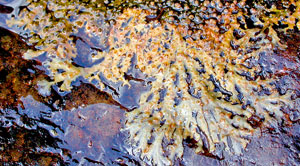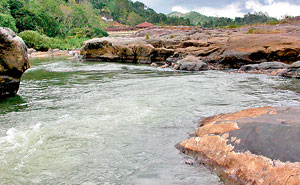While the blasting of rock and work connected to a mini-hydro power project have killed an endangered endemic freshwater fish in the Mahaweli Ganga at Waratenna, Getambe, two important aquatic plant groups, some species of which are endangered, have also suffered a similar fate.
The dynamiting has turned the habitat of a remarkable family of flowering plants and also one of the most popular aquarium plants to a watery grave, stresses Prof. Deepthi Yakandawala of the Department of Botany, Peradeniya Faculty of Science. The flowering plants include members of the family Podostemaceae and the aquarium plants the ‘water trumpet’ (Cryptocoryne, commonly known as Athi-udayan).
 |
| The Thaloid plant at Waratenna. Pic by Prof. Deepthi Yakandawala |
Six of the 10 species of the aquatic genus Cryptocoryne represented in Sri Lanka are critically endangered while all are endemic. Of the other four, three are endangered while one is vulnerable, she pointed out.
The IUCN Red List on the Fauna and Flora of Sri Lanka (2007) categorizes Cryptocoryne alba; C. bogneri, C. parva, C. undulata, C. walkeri and C. x willisii as critically endangered, according to her, with C. beckettii, C. nevillii, C. thwaitesii being endangered and C. wendtii vulnerable.
The Cryptocoryne belonging to the family Araceae mainly occurs in the south-western lowland, evergreen rainforests, central midlands (Kandy area) and central western lowlands in the semi-deciduous monsoon forests in Sri Lanka, the Sunday Times learns. “These species mostly thrive in slow running water or seasonally inundated soils. They occur submerged or emerged depending on the growth stage, vegetative or reproductive,” says Prof. Yakandawala, explaining that Sri Lanka is considered as the boundary of the distribution area of the genus towards the west.
Focusing on the area where blasting had taken place, this botanist says four Cryptocoryne species have been recorded as occurring at Waratenna (formerly known as Hakkinda) where the weir is being built. C. parva grows closest to the water where the course was rapid, C. walkeri a little further up but exposed, while C. beckettii and C. undulata were found even further up on the banks.
Referring to Podostemaceae, she says these plants live on rocks in rushing waters, in stony, rapidly flowing streams and rivers in the mid-country and lower montane zone. This family survives in a unique habitat with changing water levels. Therefore, its occurrence is restricted to a few specific localities and Waratenna is one. When the seeds get dispersed in the dry season in January-February, if they fall on a moist rock, a mucilaginous substance in the seed-coat makes them adhere closely to the rock, she says, explaining that the seeds germinate when the rock is submerged by the rains of the south-west monsoon in May. The plant body that develops is thallus-like and is firmly attached to the rock.
 |
| Site at Waratenna earlier known as Hakkinda. The white colour paths are thaloid Podostemaceae of the previous growing season. The huge rocks across the river are the ones that were being blasted till Friday |
The plants remain vegetative until the end of the rainy season. During this time they remain submerged, with water rushing over them. At the end of the rainy season as the water level falls, flower buds develop.
In January, when the water level drops further, and just when the plants are exposed to the air, the flowers open. Pollination then takes place, fruits develop, and after shedding their seed, the plants die. No longer covered with water, they become desiccated and bleached, she adds.
Farmeria metzgerioides and Polypleurum elongatum are endemic members of the seven species of Podostemaceae recorded in Sri Lanka while six of them including the two endemics are found at the blast-site at Waratenna, it is learnt.
Two weeks ago, the Sunday Times highlighted the untimely death of the freshwater fish, Gadeya or Green Laboe (Labeo fischeri) after researcher Pradeep Samarawickrama spotted the dead and decomposing fish when blasting was taking place at Waratenna.
Even after many complaints both to the Mahaweli Authority and the Central Environmental Authority, the blasting went on for some time, Pradeep lamented.
Tracing the discovery of the Labeo Fischeri in Sri Lanka in 1917, environmental lawyer Jagath Gunawardena says as it is an endemic species, it was also the first time that it was discovered in the world as well.
No published records of the fish have been available since 1990, when Rohan Pethiyagoda and Cedric Martinstyne did so from the Matale district, until Pradeep’s recent discovery, he said, adding that the Gadeya is one of the most endangered fish in Sri Lanka.
The Gadeya, usually mud green or olive green has a long, robust body with a mouth turned down and is similar to the carp. This herbivorous fish feeds on algae and requires clear flowing water and a rocky bottom which aids the growth of algae, Mr. Gunawardena added.
When asked about the importance of the Gadeya, freshwater fish specialist Sampath Gunatilleke said all species are crucial for the maintenance of the balance of the ecosystem.
Unlike big animals such as elephants about whom much research has been conducted which indicates that elephants are flagship species which create habitats through which many other species get protection, he added that only limited studies have been done on the Gadeya.
It may be later that we may learn that some of the problems that assail the Mahaweli may be due to the Gadeya going extinct, says Sampath, adding that just the fact that the Gadeya is found only in Sri Lanka and only in the Mahaweli should be a factor for its protection.
Project site work stopped for now
Work at the project site has been stopped temporarily from Friday, after a visit by Environment Minister Anura Priyadharshana Yapa and Central Environmental Authority Chairman Charitha Herath, the Sunday Times learns.
This is nearly three weeks after the initial complaints made by residents of the area about the impact on the environment.
Meanwhile, the Sunday Times understands that the presence of the gadeya is mentioned in the Environmental Impact Assessment done at the site before the project was initiated.
However, no mention is made of the fact that IUCN Listings for 1999 valid for the time of the EIA had placed the gadeya as a “highly threatened” (critically endangered) species, points out researcher Pradeep, questioning what went wrong and how experts who checked the EIA could be so blind to the facts. |



